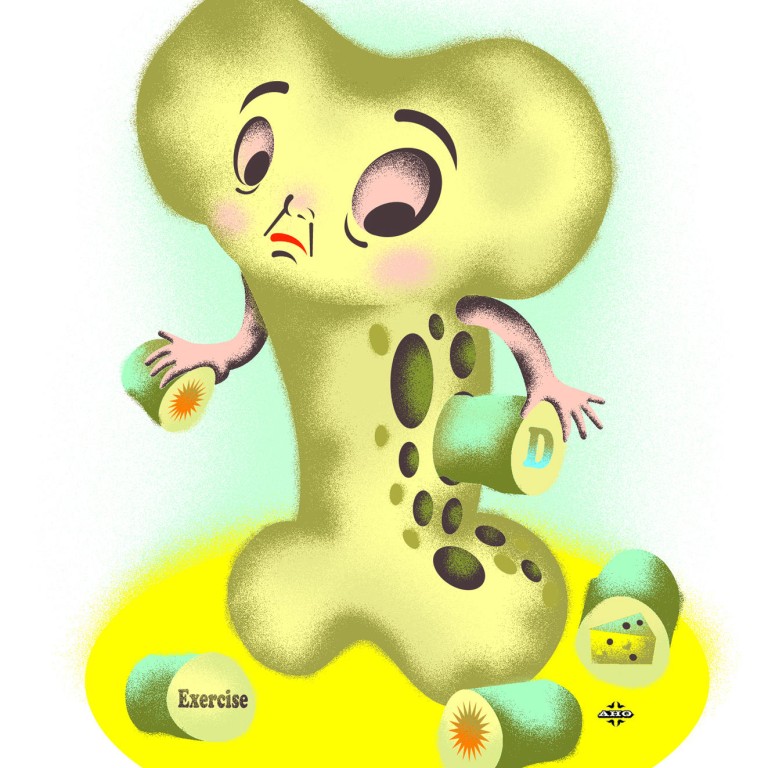
Case History: Bone disease that works undercover

An X-ray showed that Wang's wrist wasn't just broken - the bones were shattered. Tang would need to piece the tiny bone fragments back together like a jigsaw puzzle and hold the mended wrist in place with a metal plate. But something else about Wang's injury bothered Tang.
He probed further into Wang's medical history, and confirmed that she had experienced menopause about 10 years earlier. Menopause results in a dramatic fall in levels of oestrogen and progesterone, a woman's hormones. Among other things, oestrogen plays an important role in stimulating bone formation.
Bone is living tissue - it is constantly replaced by new tissue. When the action of oestrogen is reduced or removed, bone tissue may not form as quickly, or as well. This leads to a decrease in bone density, and results in brittle bones that could shatter in a fall. Given the extent of Wang's injury, Tang suspected that she had osteoporosis, or "porous bone" disease.
To confirm his suspicions, Tang had her undergo a dual-energy X-ray absorptiometry (Dexa) scan to measure her bone density. The painless and non-invasive procedure exposes the body to short bursts of X-ray beams of different energy levels. It then measures how many X-rays are absorbed by the bones, and can detect even early stages of mineral loss from the bones. The level of radiation the scan uses is less than a regular X-ray.
The results are expressed as a T-score. Normal bone density yields a T-score greater than minus one. A T-score of less than minus 2.5 confirms osteoporosis. Wang had a T-score of minus three, which was considered very low.
Like most people, a fracture was the first and only indication that Wang had osteoporosis, as the condition is usually symptom-free. But very low bone density can result in compression fractures or breaks in the bones of the spine that occur without any injury. It could also lead to a loss of up to 15cm of height over time and cause a stooped posture or a "dowager's hump".
To try to halt, or hopefully reverse, the bone density loss, Tang put Wang on calcium and vitamin D supplements. Calcium is one of the important minerals that make up bone and vitamin D is needed for the body to absorb the calcium effectively, says Tang. He also asked Wang to do gentle exercises and soak in some sunshine every day. The sun's rays also provide vitamin D which helps the body absorb calcium.
Exercise is important, because the strain exerted on bone when muscles contract helps stimulate bone formation and increase its density. Without sufficient movement, the body will assume that it no longer needs to maintain its calcium levels and starts to get rid of it, says Tang.
Hence, people who have been bedridden for long periods of time are often at risk of developing osteoporosis. Although it is often recommended that people undertake weight-bearing exercises like jogging to protect bone health, Tang says that even walking and gentle stretching exercises are good.
But given Wang's very low T-score, Tang wanted to support her bone health further with a diphosphonate, which can slow down further mineral loss in the bones. It does this by promoting the death of osteoclasts, whose job is to destroy bone, thereby helping to maintain bone density.
Tang was mindful that recent studies had shown that prolonged use of diphosphonate can paradoxically increase the risk of fractures in rare cases. Hence, once Wang was on the drug, she would have to go for check-ups twice a year and be on the lookout for complications such as pain in the jaw, hip, or abdomen.
Wang could only start the drug after the fractures in her wrist had healed, as diphosphonate can interfere with the healing process.
Six to eight weeks after her wrist repair surgery, Wang started the drug therapy, which studies show will reduce the risk of another fracture in the first five years.
Tang says that Wang's lifestyle changes, supplement intake and medication will take some time to start showing results.
She will undergo another Dexa scan in two years' time. There is a chance that the T-score may show a slight dip as her body battles to rebuild bone density, says Tang. But the best-case scenario would be a slight improvement.
Tang says that osteoporosis can affect both men and women when their hormone levels drop. He advises people to protect their bone health with regular exercise, some sunshine, and adequate intake of calcium and vitamin D.
Women who have reached menopause should monitor their bone health by undergoing bone density tests.
Osteoporosis is a silent disease, and if you discover it because of a fracture, the damage to your body's supportive structure has already been done.
